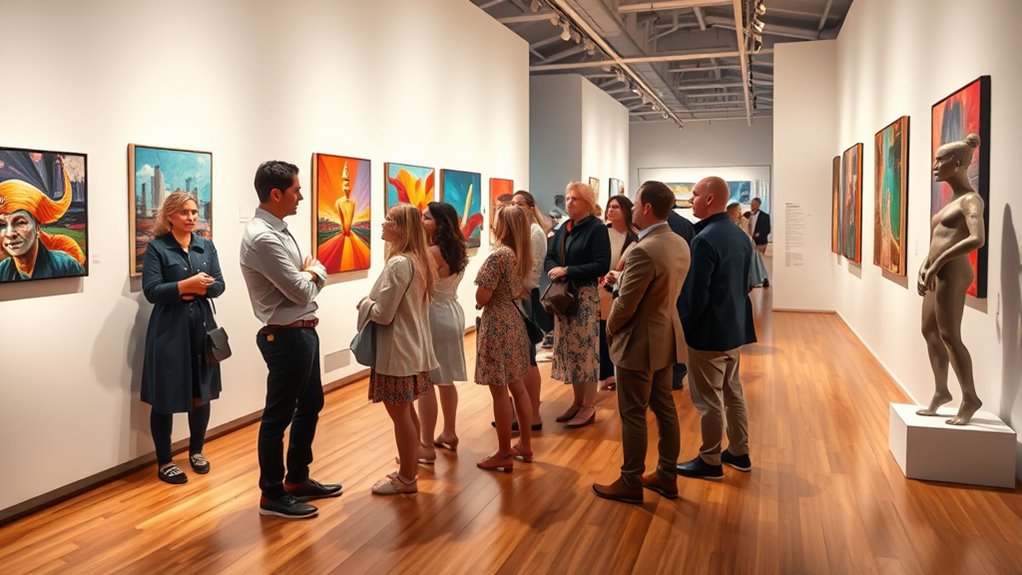To evaluate emerging artists for investment, look at their creative innovation, authenticity, and how their style evolves over time. Check their market presence through social media, exhibitions, and critical coverage. Review their educational background and industry collaborations to gauge professionalism. Consider their long-term growth potential by analyzing trends, network strength, and adaptability to change. To make smarter choices, understanding these factors will help you identify promising talent; exploring further will give you even more useful insights.
Key Takeaways
- Assess the artist’s originality, innovation, and consistency in developing a unique artistic voice and evolving style.
- Analyze market presence through social media engagement, media coverage, and participation in exhibitions or performances.
- Review educational background and professional experience for technical skills and career sustainability.
- Consider long-term growth potential by evaluating adaptability, experimentation, and relevance to current market trends.
- Understand cultural influences and personal motivations that add authenticity and emotional depth to the artist’s work.
Analyzing Artistic Innovation and Creativity
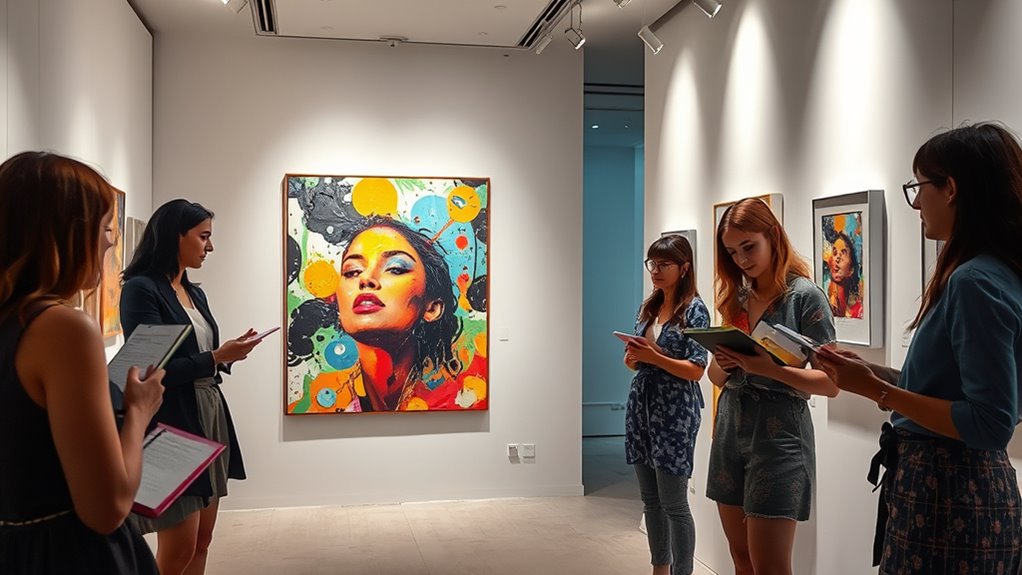
When evaluating emerging artists, understanding their capacity for innovation and creativity is essential. You’ll want to look at how they push boundaries through digital art, experimenting with new tools and techniques that redefine visual expression. Consider their engagement with performance art, where spontaneity and physical presence challenge traditional formats. These mediums demonstrate their willingness to explore uncharted territory and craft unique experiences. Innovative artists don’t just replicate existing styles; they fuse different disciplines, creating fresh perspectives. Their ability to evolve concepts, incorporate technology, and evoke emotional responses shows their potential to stand out. Keep an eye on how they challenge norms and develop original ideas—these traits signal their capacity for sustained creative growth and influence in the art world. Additionally, understanding their artistic innovation can help assess their long-term potential to impact creative fields and redefine artistic boundaries.
Assessing Market Reception and Visibility
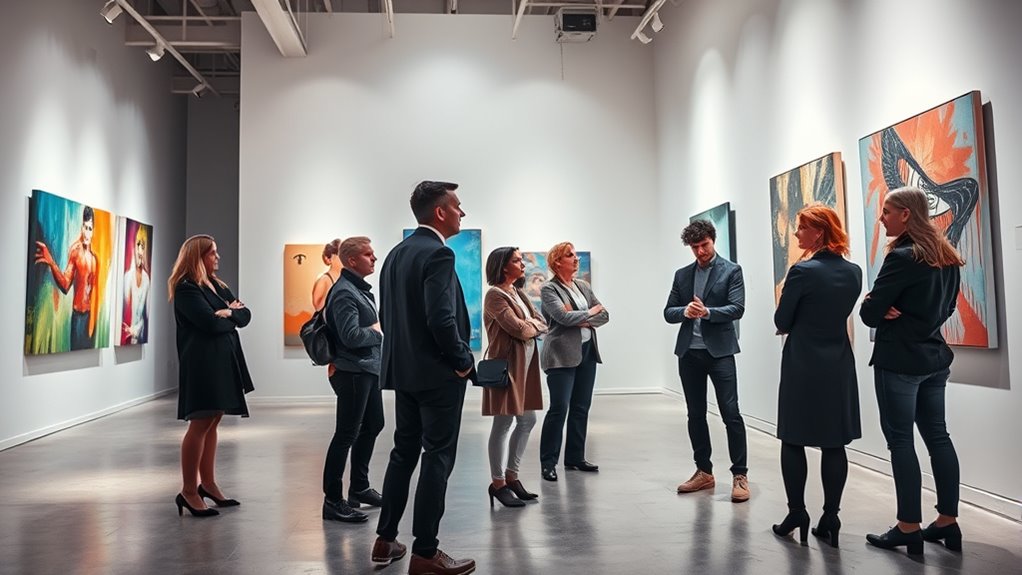
Evaluating market reception and visibility is essential for identifying an emerging artist’s potential for success. You need to analyze how well their work resonates within current market trends and gauge their reach among diverse audience demographics. Visibility can be measured through social media presence, gallery exhibitions, and media coverage. Market trends indicate where the industry is headed, helping you spot artists with growth potential. Consider this table:
| Aspect | Key Indicators | Impact on Investment |
|---|---|---|
| Social Media Reach | Followers, engagement rates | Shows audience interest |
| Media Coverage | Articles, reviews, features | Enhances visibility and credibility |
| Event Participation | Exhibitions, performances | Demonstrates active market presence |
| Audience Demographics | Age, location, interests | Guides target market fit |
| Market Trends | Popular styles, emerging genres | Aligns investment with future demand |
Additionally, understanding content quality is vital, as high-quality work tends to attract more attention and credibility within the art community.
Examining the Artist’s Educational and Professional Background
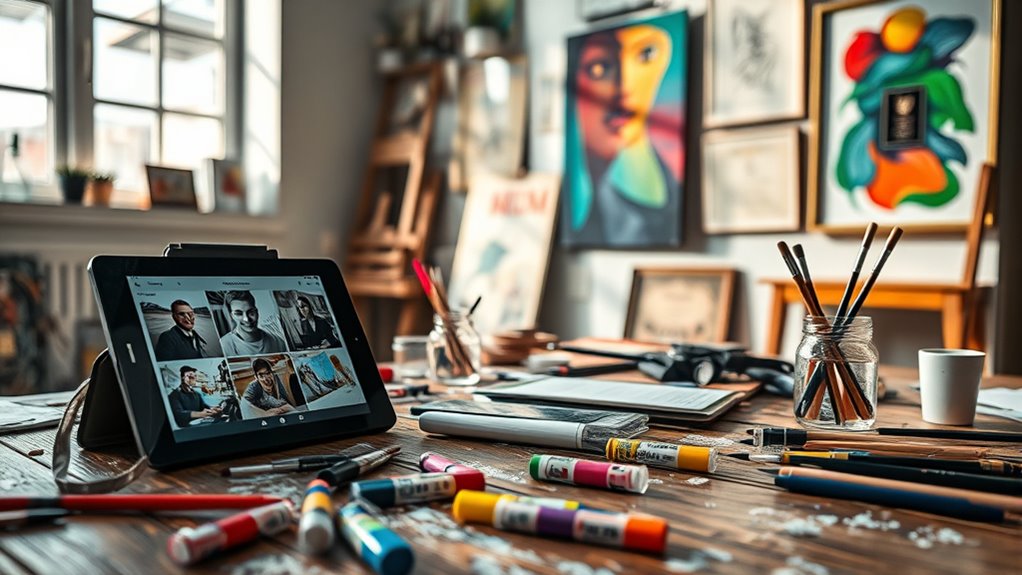
A thorough examination of an artist’s educational and professional background provides critical insights into their skill level, discipline, and industry experience. You should look at their formal training, certifications, and any art programs they attended, as these shape their technical skills. An artist’s education can also reflect their approach to artist branding, showing how they position themselves within the art world. Equally important is their professional experience—exhibitions, collaborations, commissions—that demonstrates their ability to sustain a career. Strong educational credentials paired with consistent industry engagement suggest dedication and discipline, key indicators of future growth. By analyzing these aspects, you gain a clearer understanding of their foundational competencies and potential for long-term success in the competitive art market.
Considering the Uniqueness and Authenticity of the Work
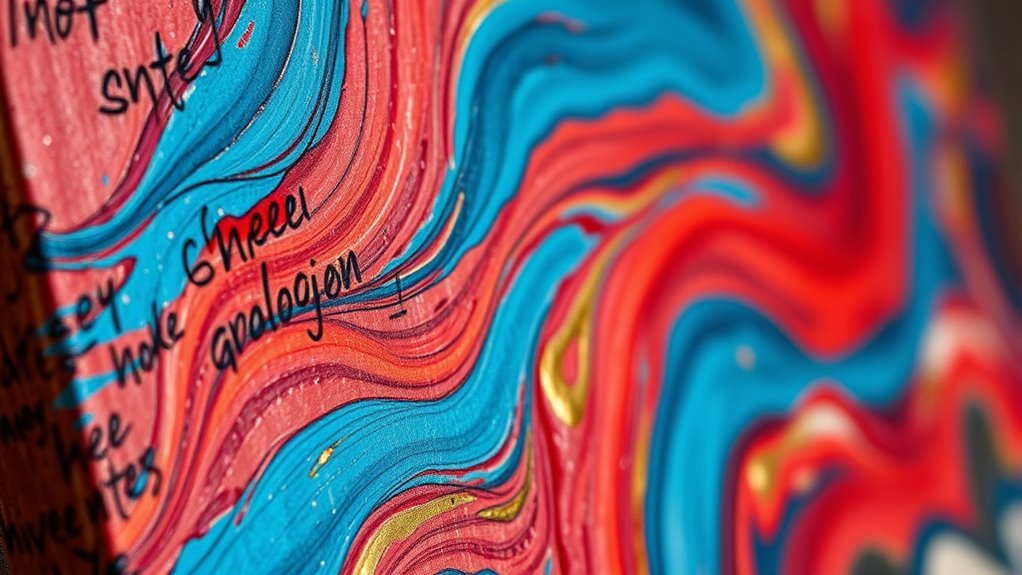
When evaluating an artist’s work, focus on its originality and the voice that sets it apart. Consider how their cultural and personal experiences shape their creations, adding depth and authenticity. Ultimately, observe whether their work shows consistent growth or meaningful evolution over time. Incorporating self-reflection into your assessment can also enhance your understanding of their development and potential.
Artistic Originality and Voice
| Artistic Style | Creative Influences |
|---|---|
| Defines the artist’s unique expression | Shapes the originality through external inspirations |
| Reflects authentic voice | Connects personal background to work |
| Demonstrates innovation | Shows how influences are integrated |
| Distinguishes from others | Reveals the artist’s perspective |
| Evolving over time | Adapts influences into a personal style |
Artistic originality and voice are essential indicators of an emerging artist’s potential, as they reveal the work’s true character and authenticity. Your focus should be on the artist’s unique artistic style and how they incorporate creative influences. Look for work that demonstrates innovation and a distinctive voice, setting it apart from others. Consider whether the artist’s influences are integrated seamlessly, reflecting genuine inspiration rather than imitation. An evolving style indicates growth and authenticity, essential qualities for future success and investment potential. Additionally, understanding artistic development can help assess how an artist’s style may mature over time, increasing their long-term viability. Ultimately, the more the work resonates with originality and a clear voice, the stronger its potential for lasting impact.
Cultural and Personal Context
Understanding the cultural and personal context behind an artist’s work is essential for evaluating its authenticity and uniqueness. Cultural influences shape the themes, symbols, and techniques an artist chooses, revealing deeper connections to their background. Personal motivations drive the stories they tell and the messages they want to convey, making their work more genuine. When you analyze these aspects, you gain insight into what motivates their creativity and how their experiences inform their art. Recognizing the interplay between cultural influences and personal motivations helps you determine whether an artist’s work reflects true originality or simply follows trends. Emotional alignment plays a significant role in how artists express their authentic selves through their creations. Ultimately, this context deepens your appreciation and informs your investment decision, ensuring you support artists whose work embodies authentic expression rooted in meaningful personal and cultural narratives.
Consistency and Evolution
Evaluating an artist’s work involves examining both its consistency over time and its capacity for meaningful evolution. You want to see if their style remains authentic while adapting to new ideas. Consistent work showcased in gallery exhibitions demonstrates reliability and a strong voice. Equally important is their evolution, which signals growth and responsiveness to current trends. A well-connected artist often expands their collector networks, reflecting increasing recognition. Consider this table:
| Consistency | Evolution | Recognition |
|---|---|---|
| Regular gallery shows | New mediums explored | Growing collector base |
| Signature style | Style refinement | Industry awards |
| Authentic themes | Responds to feedback | Critical praise |
This balance indicates a genuine artist with potential for long-term investment. Additionally, diverse designs and the capacity to incorporate innovative techniques further enhance an artist’s appeal and marketability.
Evaluating Critical Reception and Media Coverage
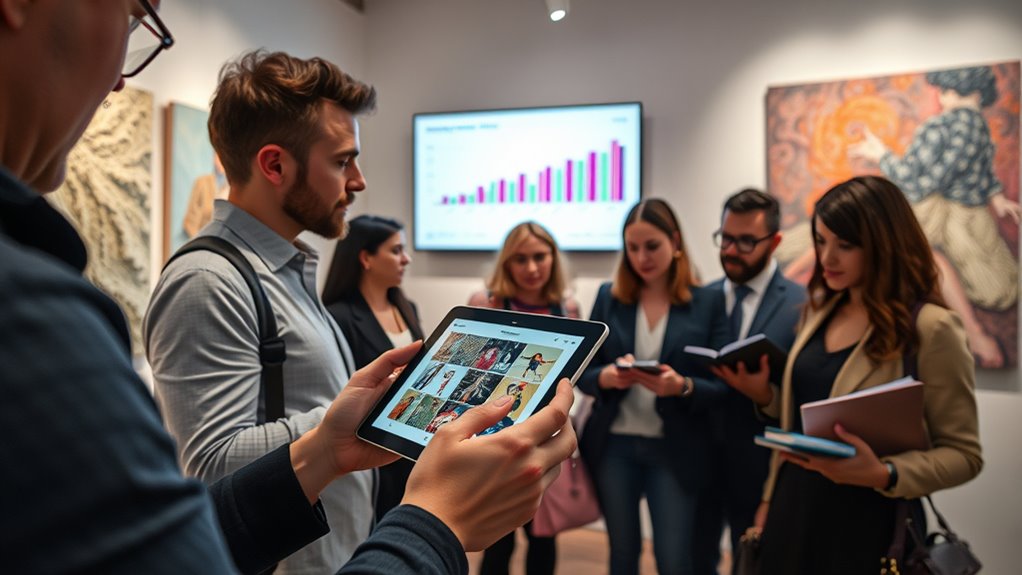
How do critics and media outlets shape perceptions of emerging artists? Their coverage creates media buzz that influences public opinion and investor interest. Critical reviews can make or break an artist’s reputation early on, affecting future opportunities. To evaluate this, consider these key factors:
Critics and media coverage significantly influence public perception and future success of emerging artists.
- The tone and consistency of critical reviews
- The reach and influence of major media outlets
- The speed and volume of media buzz surrounding the artist
- The presence of positive or negative press in industry publications
- How well the artist’s work resonates with critics and audiences alike
- The media coverage’s overall sentiment, as it provides insight into an artist’s potential for growth and recognition. Critical reception often acts as a barometer for future success and investment viability.
Understanding the Artist’s Network and Collaborations
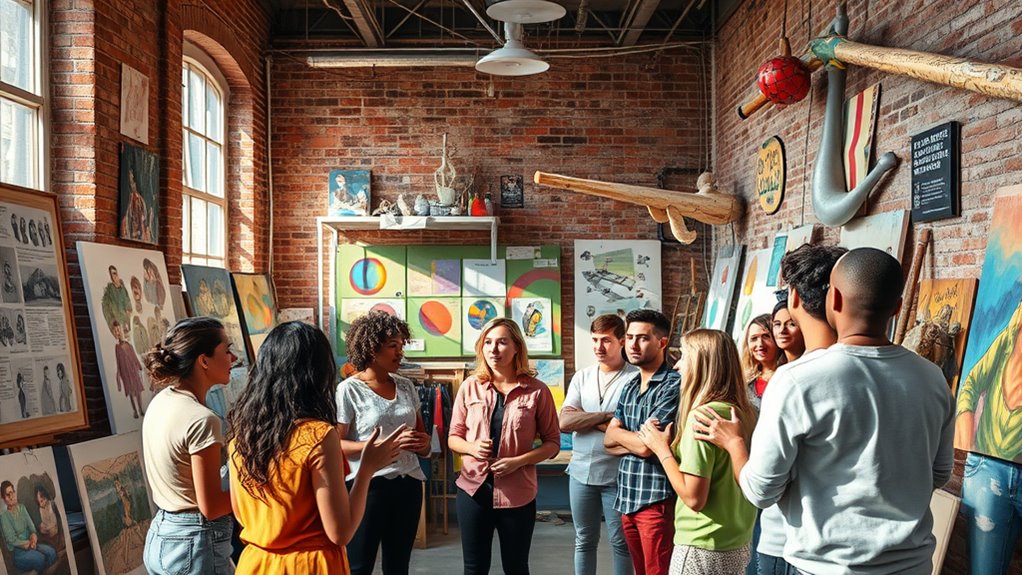
To assess an emerging artist’s potential, you should examine their collaboration diversity and reach across different genres and audiences. Key industry partnerships can also indicate credibility and future growth opportunities. Don’t forget to check their social media engagement, as it reflects their network influence and connection with fans.
Collaboration Diversity and Reach
Understanding an emerging artist’s network and collaborations reveals much about their potential for growth and influence. A diverse range of collaborative networks indicates their ability to connect across genres, audiences, and platforms, expanding their reach. Look for artists who actively employ outreach strategies that foster varied partnerships, demonstrating adaptability and openness to new ideas. A strategic approach to network expansion can significantly enhance an artist’s visibility and sustainability in a competitive market.
Diverse collaborations not only broaden an artist’s audience but also showcase their versatility and ambition, making them more appealing for investment.
Key Industry Partnerships
Examining an emerging artist’s key industry partnerships offers direct insight into their professional network and potential for sustained growth. Look for active gallery collaborations, which indicate recognition and support within the art community. Strong gallery relationships can open doors to exhibitions, collectors, and critical validation. Additionally, consider their brand endorsements, as these reflect commercial appeal and marketability beyond the gallery setting. Successful partnerships with brands can boost visibility and demonstrate the artist’s ability to connect with broader audiences. These collaborations often lead to increased opportunities and financial stability, making the artist more attractive for investment. A well-established network of gallery collaborations and endorsements signals stability, influence, and growth potential, essential factors in evaluating the long-term viability of emerging artists. Incorporating market trends and staying updated on industry shifts can further inform investment decisions.
Social Media Engagement
How does an artist’s social media presence reveal their network and collaborations? By analyzing their engagement, you can identify key partnerships, influencer collaborations, and industry ties. Social media algorithms often highlight artists connected with popular influencers, boosting visibility. Look for frequent collaborations or shared content with other artists, which signals strong professional ties. Engagement metrics, like comments and shares, show how actively their network interacts with them. Understanding social media algorithms can help you determine which connections are most influential. Engagement metrics, like comments and shares, show how actively their network interacts with them. An artist’s tagging habits and who they follow also reveal strategic alliances. These insights help you assess their influence and growth potential. Recognizing patterns in their social media activity provides a clear picture of their standing within the industry, making it easier to evaluate their future investment potential effectively.
Projecting Long-Term Relevance and Growth Potential

To project an artist’s long-term relevance and growth potential, you need to evaluate both their evolving creative trajectory and their ability to adapt to changing industry trends. Consider how they navigate market saturation—standing out without losing authenticity. An artist demonstrating artistic maturity shows consistent growth and a clear vision, which signals longevity. Look for signs they’re expanding their skill set, experimenting with new styles, or refining their message. If they can balance innovation with a solid foundation, they’re more likely to sustain relevance over time. Their ability to evolve creatively, while maintaining core identity, indicates potential for continued growth. Additionally, observing how they incorporate innovative approaches and sustainable practices can further signal their capacity for long-term success in a competitive industry landscape. This combination of adaptability and maturity helps predict whether they’ll remain influential in an ever-shifting industry landscape.
Identifying Investment Risks and Market Trends
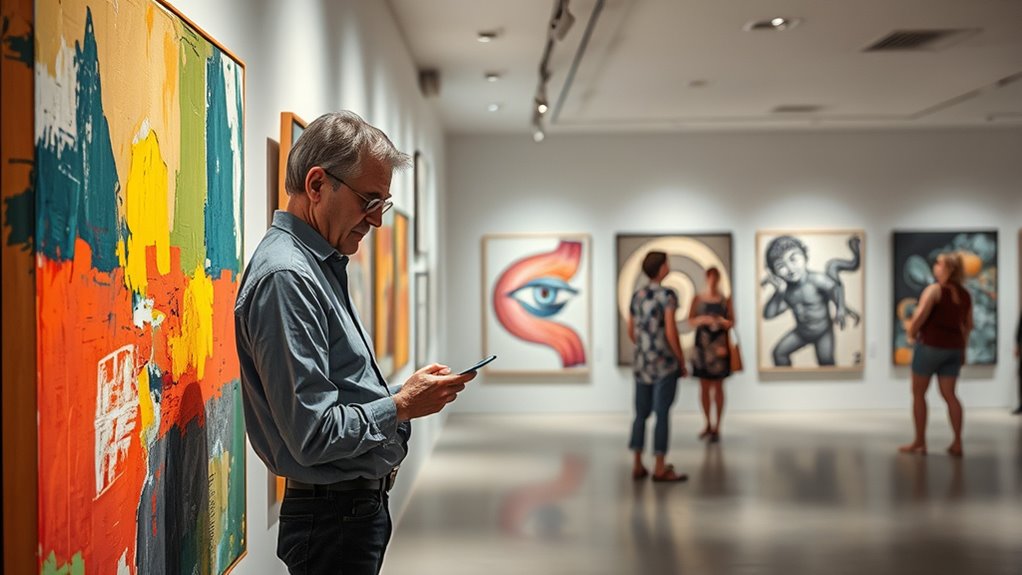
Understanding investment risks and market trends is essential for making informed decisions in the art industry. Market volatility can cause sharp fluctuations in artist valuations, so stay alert to shifts that might impact your investments. Regulatory changes also influence the market, potentially affecting artists’ ability to sell or exhibit work. To navigate these risks, consider these key points:
- Monitor economic indicators affecting art demand
- Track upcoming regulatory reforms
- Assess artists’ adaptability to market changes
- Observe shifts in collector preferences
- Stay updated on global art market fluctuations
- Be aware of affiliate disclosures that may influence market perceptions and transparency.
Frequently Asked Questions
How Do I Identify Hidden Talent in Emerging Artists?
When trying to spot hidden talent in emerging artists, look for those who showcase emerging trends and artistic innovation. You should observe their unique approach, originality, and how they push boundaries within their work. Pay attention to their ability to adapt and grow, as well as how they engage with new ideas. Trust your instincts and stay curious about their potential to influence future art movements. These signs often reveal true talent.
What Are the Key Financial Indicators for Art Investment?
You should focus on key financial indicators like market valuation and price appreciation when evaluating art investments. Check how similar works are valued in the market and track their price trends over time. Rising market valuation and consistent price appreciation suggest strong investment potential. By analyzing these indicators, you can make informed decisions, understanding whether an artwork’s value is likely to grow and if it fits your investment goals.
How Does Cultural Relevance Influence an Artist’S Investment Potential?
Cultural relevance greatly boosts an artist’s investment potential because their work resonates with current societal trends and reflects cultural impact. When an artist addresses timely issues or embodies popular movements, it increases demand and visibility. You should look for artists whose work engages with society’s conversations, as this relevance often leads to higher valuation and long-term appreciation. Staying attuned to cultural shifts helps you identify promising talents positioned for growth.
What Role Does Artist Age Play in Investment Decisions?
When considering an artist’s age, you should think about market maturity and career longevity. Younger artists often bring fresh perspectives and have longer potential careers, which can mean higher growth opportunities. However, older artists may have established reputations and proven track records, offering stability. Your investment decision hinges on balancing these factors, evaluating how age relates to their ability to sustain relevance and grow within the evolving art market.
How Can I Assess an Artist’S Future Market Sustainability?
Mastering market movements means you should scrutinize an artist’s sustainability seamlessly. Study current market trends to spot stability and growth potential. Pay attention to their branding strategies, ensuring they resonate and remain relevant. Look for consistent creativity, community engagement, and adaptability. A resilient artist’s future market sustainability depends on their ability to evolve with trends while maintaining a unique identity, ensuring long-term success and investment security.
Conclusion
By thoughtfully exploring these aspects, you’ll gently uncover the hidden gems among emerging artists. While no path is entirely without its twists, paying attention to innovation, authenticity, and connections can guide you toward promising opportunities. Trust your instincts and stay attuned to evolving trends, knowing that patience and discernment often lead to rewarding discoveries. With careful consideration, you can navigate the vibrant art scene and perhaps find a piece that resonates long into the future.
